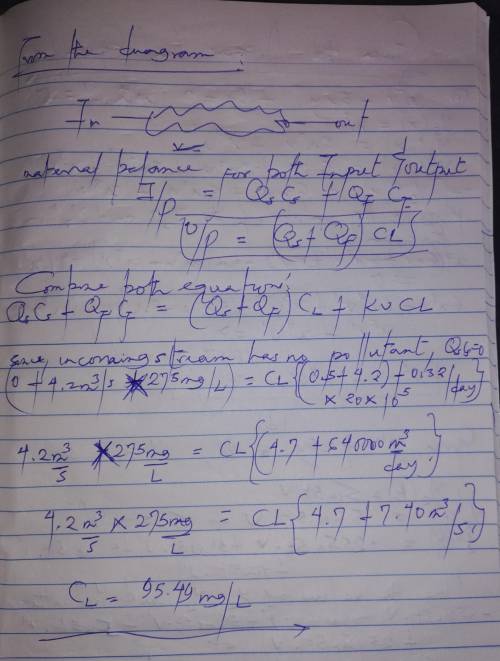
Engineering, 03.03.2020 02:58 wolffee895
Consider a 20 * 105 m3 lake fed by a polluted stream having a flow rate of 4.2 m3/s and pollutant concentration equal to 25 mg/L and fed by a sewage outfall that discharges 0.5 m3/s of wastewater having a pollutant concentration of 275 mg/L. The stream and sewage wastes have a second order decay rate of 0.32 L/(mg-day). Assuming the pollutant is completely mixed in the lake and assuming no evaporation or other water losses or gains, find the steady-state pollutant concentration in the lake. Derive the equation from the mass balance on C in the lake for full credit. Note that the quadratic equation will be useful for solving this problem.

Answers: 1


Another question on Engineering

Engineering, 03.07.2019 14:10
Line joining liquid phase with liquid and solid phase mixture is known as: a) liquidus b) solidus c) tie line d) none of the mentioned
Answers: 2

Engineering, 04.07.2019 18:10
Fluids at rest possess no flow energy. a)- true b)- false
Answers: 3

Engineering, 04.07.2019 18:10
During a steady flow process, the change of energy with respect to time is zero. a)- true b)- false
Answers: 2

Engineering, 04.07.2019 18:10
Adouble-strand no. 60 roller chain is used to transmit power between a 13-tooth driving sprocket rotating at 300 rev/min and a 52-tooth driven sprocket. a) what is the allowable horsepower of this drive? b) estimate the center-to-center distance if the chain length is 82 pitches. c) estimate the torque and bending force on the driving shaft by the chain if the actual horsepower transmitted is 30 percent less than the corrected (allowable) power.
Answers: 3
You know the right answer?
Consider a 20 * 105 m3 lake fed by a polluted stream having a flow rate of 4.2 m3/s and pollutant co...
Questions


Business, 19.09.2019 02:00

History, 19.09.2019 02:00

Mathematics, 19.09.2019 02:00



Social Studies, 19.09.2019 02:00



History, 19.09.2019 02:00



Mathematics, 19.09.2019 02:00


History, 19.09.2019 02:00

Mathematics, 19.09.2019 02:00


Social Studies, 19.09.2019 02:00

Physics, 19.09.2019 02:00





